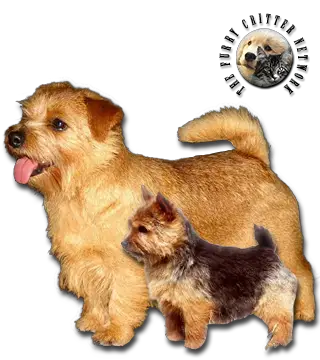Breed Standard
Head: Round, broad, slightly domed skull. Distinct stop. Strong wedge-shape muzzle. Strong jaws, tight lips.
Ears: Medium size, V-shaped, slightly rounded tips, falling forward against the cheeks.
Eyes: Oval. Dark chestnut or dark color.
Body: Compact, strong neck. Horizontal topline. Ribs well sprung. Short back.
Tail: Medium docked, carried erect. Medium length, thick at the root and tapering to the tip. Carried straight and proudly.
Hair: Hard, wiry, straight, lying close to the skin. Longer and
bushier on the neck and shoulders.
Coat: All shades of red, wheaten, black and tan or grizzle. White markings or patches are not permissible.
Size: 25 to 26 cm (9,8 to 10,2 in).
Weight: Approximately 5kg (11lb).
History
In the 1880s, British sportsmen developed a working terrier of East Anglia in eastern England. The Norwich Terrier and later the drop-eared variety now known as the Norfolk Terrier, were believed to have been developed by crossing local terrier-like dogs, small, short-legged Irish Terrier breeds and the small red terriers used by the Romani ratters of Norfolk (the county of which Norwich is the county town).
They were first called the Cantab Terrier when they became fashionable for students to keep in their rooms at Cambridge University in England. Later, they were called the Trumpington Terrier, after Trumpington Street where the breed was further developed at a livery stable. Then, just prior to World War I, a prominent Irish horse rider Frank Jones sold quantities of the short-legged terriers to the United States, so there they were called Jones Terriers. It was Jones who designated the terriers were from Norwich.
In 1932, the Norwich was granted acceptance into the English Kennel Club and the first written standard was created. The American Kennel Club registered the first Norwich Terrier in 1936. In 1964, The Kennel Club reclassified the drop-ear variety as it its own breed, the Norfolk Terrier, and the prick-eared variety retained the name Norwich Terrier. The American Kennel Club and Canadian Kennel Club both recognized the division of the Norwich Terrier breed in 1979. The Norfolk Terrier was recognized by the United Kennel Club in 1979.
Behavior
Norfolks are described as fearless, but can have an independent streak. They, along with Norwich Terriers and Border Terriers, have the softest temperaments of the Terrier Group. Norfolks work in packs and must get along with other dogs. As companions, they love people and children and do make good pets. Their activity level is generally reflective of the pace of their environment. This breed should not be kept or live outside since they thrive on human contact.
Generally, Norfolks are not given to digging but, like any dog, will dig out of boredom when left alone for too long a period. Norfolks are not yappers and are not particularly vocal; however, they will bark when appropriate given their watch-dog tendencies. They generally cohabit well with other household pets when introduced as a puppy. Outdoors, they are natural hunters with a strong prey drive for small vermin.
Norfolks were originally bred as barn dogs to rid the barn of vermin. Some literature suggest that they were also occasionally used on the hunt to bolt animals of equal size from their den.
To some extent they are still used in that capacity in continental Europe. Norfolks are pack animals and hence expected to get along with other dogs while working or in the home. As a pack dog, they take turns working their prey. They are fearless and their courage is incredible. Today, of course, they are household companions and must have an agreeable disposition for living with people.
The Norfolk can live in a city if he gets out often to burn off excess energy. Daily brushing is required. This breed should be professionally groomed two to four times per year.
Function
Hunting Dog, Pet.
Health
The life expectancy of a Norfolk Terrier is 8–14 years, with some growing as old as 17 years. Norfolks do have incidences of mitral valve disease, luxating patellas, and incorrect bites (where the teeth do not align with the breed standard, i.e. overshot or undershot). Norfolks most often have shallow hip sockets and many breedlines are dysplastic. There has never been a Norfolk Terrier recognized by the Orthopedic Foundation for Animals (OFA) as having "excellent" rated hips. Therefore, responsible breeders are testing for hip dysplasia. Breeders that do not radiograph hips and have them evaluated by either OFA or PennHip, cannot answer questions regarding hip dysplasia in their breeding program.
Norfolks generally have medium to small litters. Responsible breeders only breed healthy dogs who are of good temperament, good pedigree lineage and best reflect the breed standard. The demand for Norfolk is far greater than the supply. The environment in which they are raised directly impacts the temperament of the puppy for its lifetime.






